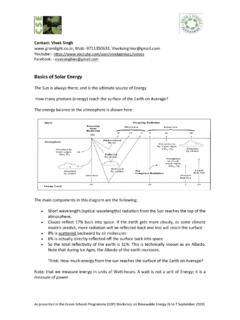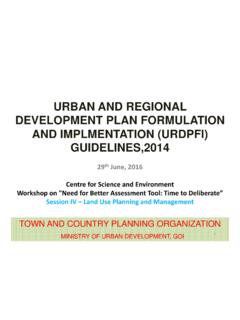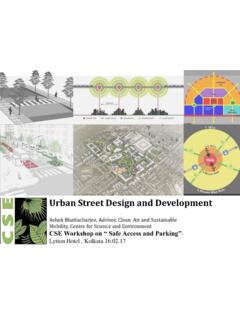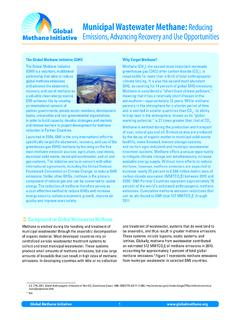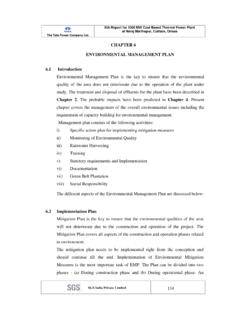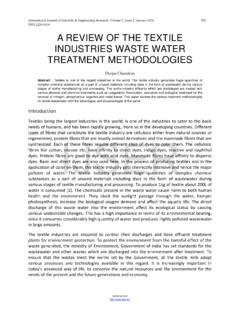Transcription of THE RIVER, ITS POLLUTION AND WHAT WE CAN DO TO …
1 THE RIVER, ITS. POLLUTION AND. WHAT WE CAN DO. TO CLEAN IT. A Centre for Science and Environment briefing paper Writer: Sunita Narain Editor: Souparno Banerjee Design: Ajit Bajaj Production: Rakesh Shrivastava, Gundhar Das 2014 Centre for Science and Environment Material from this publication can be used, but with acknowledgement. Maps in this report are indicative and not to scale. Published by Centre for Science and Environment 41, Tughlakabad Institutional Area New Delhi 110 062. Phones: 91-11-29955124, 29955125, 29953394. Fax: 91-11-29955879. E-mail: Website: Printed at Multi Colour Services 2. THE RIVER, ITS. POLLUTION AND. WHAT WE CAN DO. TO CLEAN IT. A Centre for Science and Environment briefing paper 3. Ganga: the run of the river Passing through five states, the Ganga covers 26 per cent of the country's landmass.
2 Despite the enormous amounts of money spent on cleaning it, the river continues to run polluted. Worse, the POLLUTION is increasing even in stretches that were earlier considered clean Numerous hydel projects Decreased environmental flow Gangotri Devprayag Relatively cleaner Rudraprayag Rishikesh But assimilative capacity decreasing UTTARAKHAND Growing POLLUTION Ga ng a UTTAR PRADESH. Kanpur Growing cities Patna Sangam Mokama Polluting industries Allahabad Varanasi BIHAR. Very high Behrampore POLLUTION levels JHARKHAND. WEST BENGAL Dakshineshwar Garden Reach Diamond Harbour High Uluberia POLLUTION levels UTTARAKHAND UTTAR PRADESH BIHAR JHARKHAND WEST BENGAL. 450 km 1,000 km 405 km 40 km 520 km 14 drains 43 drains 25 drains 54 drains 440 MLD 3,270 MLD 580 MLD 1,780 MLD.
3 Note: MLD: million litre per day (the figures refer to the collective discharge from the drains into the river). Source: CPCB 2013, POLLUTION Assessment: River Ganga, Central POLLUTION Control Board, MoEF, July 4. GANGA: THE RIVER, ITS POLLUTION AND WHAT WE CAN DO TO CLEAN IT. G. anga is India's largest river basin: it covers 26 per cent of the country's landmass and supports 43 per cent of its population. In 1986, the gov- ernment of India launched the Ganga Action Plan (GAP). In August 2009, GAP was re-launched with a reconstituted National Ganga River Basin Authority. The objectives in the past 30-odd years have remained the same: to improve the water quality of the river to acceptable standards (defined as bathing water quality standards) by preventing POLLUTION from reaching it in other words, intercepting the sewage and treating it before discharge into the river.
4 But despite programmes, funds and some attention, the Ganga still runs polluted. Worse, recent studies show that POLLUTION is increasing even in the stretches which were earlier considered clean. What can be done? What is the way ahead? This paper puts forward the state of the river and the steps that need to be taken to make Ganga live' forever. A. POLLUTION Current state, why is it so, and the way ahead The Ganga Action Plan (GAP-I) had selected 25 towns located along the river in Uttar Pradesh, Bihar and West Bengal. In 1993, the second phase (GAP-II). continued the programme, but included work on four tributaries of the river . Yamuna, Gomti, Damodar and Mahanadi. In August 2009, the Union government re-launched the Ganga Action Plan with a reconstituted National Ganga River Basin Authority (NGRBA).
5 Under the notification, dated February 20, 2009, the government gave the river the status of a National River. The objective was to ensure abatement of POLLUTION and conservation of the river. The key difference between the first Ganga Action Programme and now, is the recognition that the entire basin of the river has to be the basis for planning and implementation. It is not enough to plan for one city's POLLUTION , without considering the impact of the POLLUTION on the downstream area. It is accepted that the plan for POLLUTION control must take into account the need for adequate water in the river its ecological flow. How polluted is the river? The challenge of POLLUTION remains grim. According to July 2013 estimates of the Central POLLUTION Control Board (CPCB), fecal coliform levels in the main- stream of the river some 2,500 km from Gangotri to Diamond Harbour.
6 Remain above the acceptable level in all stretches, other than its upper reaches. 5. Fecal coliform (PMN /100 ml). 6. 1. 10. 100. 1,000. 10,000. 100,000. 1,000,000. Bhagirathi at Gangotri Alaknanda B/C Mandakini at Rudra Prayag Mandakini B/C Alaknanda at Rudra Prayag Alaknanda A/C Mandakini at Rudra Prayag Alaknanda B/C to Bhagirathi at Devprayag 2007. Bhagirathi B/C with Alaknanda at Devprayag Alaknanda A/C with Bhagirathi at Devprayag Ganga at Rishikesh U/S. Ganga A/C of river Song near Satyanarayan temple D/S Raiwala Ganga at Haridwar D/S. Upper Ganga river D/S Roorkee Ganga at Garhmukteshwar 2011. Ganga U/S, Anoopshahar 1,208 MLD. Ganga D/S, Anoopshahar Ganga at Narora (Bulandsahar), UP. INSTALLED CAPACITY OF STPS. Ganga at Kachhla Ghat, Aligarh Ganga at Kannauj U/S (Rajghat).
7 Ganga at Kannauj D/S, UP. Ganga at Bithoor (Kanpur). Ganga at Kanpur U/S (Ranighat). Criteria Ganga at Kanpur D/S (Jajmau pumping station), UP. Ganga at Dalmau (Rae Bareilly). Ganga at Kala Kankar, Rae Bareilly Ganga at Allahabad (Rasoolabad), UP. Ganga at Kadaghat, Allahabad Ganga at Allahabad D/S (Sangam), UP. Ganga U/S, Vindhyachal, Mirzapur 2,723 MLD. 6,087 MLD. Ganga D/S, Mirjapur OFFICIAL SEWAGE LOAD. Ganga at Varanasi U/S (Assighat). MEASURED SEWAGE LOAD. Ganga at Varanasi D/S (Malviya bridge), UP. Source: CPCB 2013, POLLUTION Assessment: River Ganga, Central POLLUTION Control Board, MoEF, July Ganga at Trighat (Ghazipur). Varanasi Ganga's journey: Gangotri to Diamond Harbour Ganga at Buxar, Ramrekhaghat Ganga at Indrapuri, Dehri-on-Son GAP.
8 GAP. Ganga at the confluence of Son river, Doriganj, Chhapra Ganga at Khuri, Patna U/S. Ganga, Darbhanga ghat at Patna 55%. 80%. Ganga at Patna D/S (Ganga bridge). Ganga at Punpun, Patna Ganga at Fathua Ganga at Mokama (U/S). Ganga at Mokama (D/S). Fecal coliform levels in 2007 and 2011 even cleaner stretches are becoming polluted Ganga at Munger Ganga at Sultanganj, Bhagalpur Ganga at Bhagalpur Ganga at Kahalgaon Ganga at Baharampore Ganga near Burning Ghat Ganga at Sertampore Ganga at Dakshineshwar Nabadip on Ganga, Ghoshpara near Monipurghat Ganga at Howrah, Shivpur Ganga at Garden Reach Ganga at Uluberia Ganga at Palta, West Bengal Ganga at Diamond Harbour GANGA: THE RIVER, ITS POLLUTION AND WHAT WE CAN DO TO CLEAN IT. Key problems and approaches There are three problem areas that need to be addressed in order to find a comprehensive solution to Ganga POLLUTION : The inadequate flow of water in the river, needed to dilute and assimilate waste The growing quantum of untreated sewage discharged from cities along the river The lack of enforcement against point-source POLLUTION from industries discharging waste into the river.
9 But even in these reaches, there are worrying signs as fecal coliform levels are increasing in places like Rudraprayag and Devprayag, suggesting that there is inadequate flow for dilution even in these highly oxygenated stretches (see Graph: Ganga's journey: Gangotri to Diamond Harbour). The POLLUTION levels are a cause of worry in the hotspots the mega and fast growing cities along the river. According to the CPCB's monitoring data, biological oxygen demand (BOD) levels are high downstream of Haridwar, Kannauj and Kanpur and peak at Varanasi. But what is worrying is that in all the stretches, POLLUTION is getting worse. This is not surprising given that all along this heavily populated stretch, freshwater intake from the river is increas- ing.
10 In this way, water is drawn for agriculture, industry and cities but what is returned is only waste. Funds have been used up to create infrastructure, without much attention paid to the use and efficacy of this hardware. But with all this done, the cities are still losing the battle with the amount of infrastructure that has yet to be built to convey the sewage and then of course, to treat it and dispose of it. 7. Ecological flow and the need for dilution Rivers have a self-cleansing ability, which allows for assimilation and treat- ment of biological waste. But in the current context, where withdrawal from the river is much higher than the discharge of waste, POLLUTION is inevitable. In the upper reaches of the river, where the oxygenating abilities of the river are the highest, there are growing signs of contamination.


